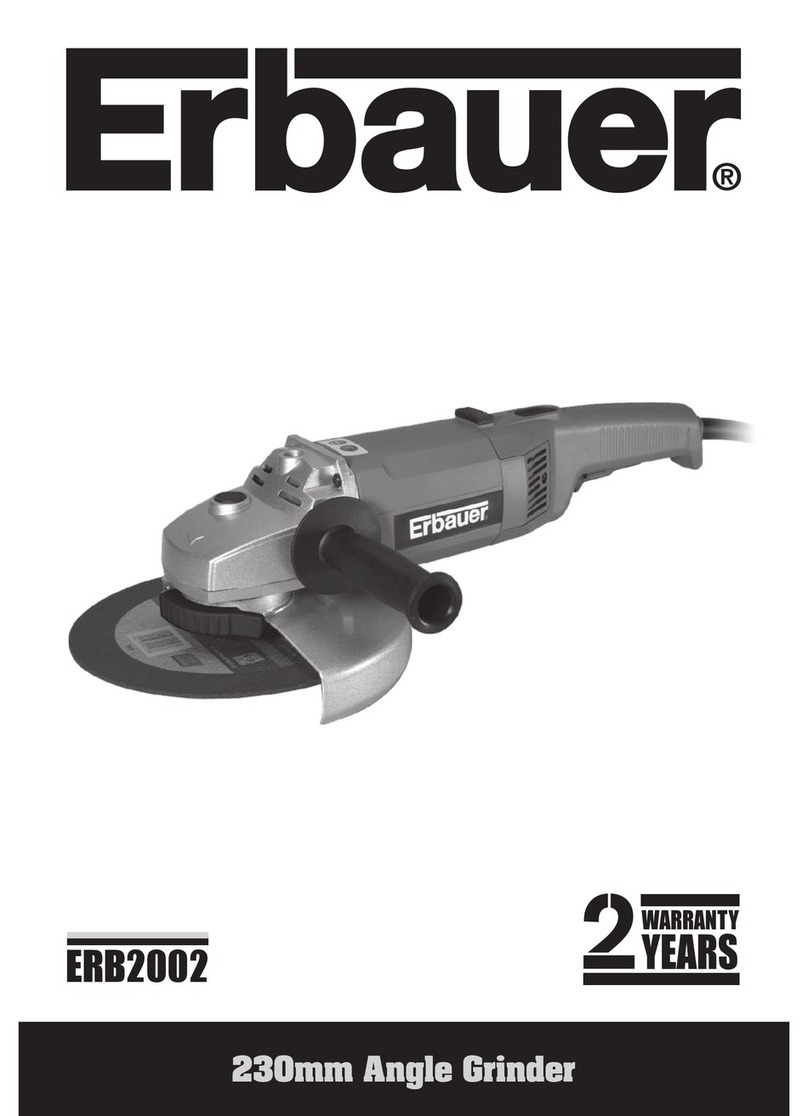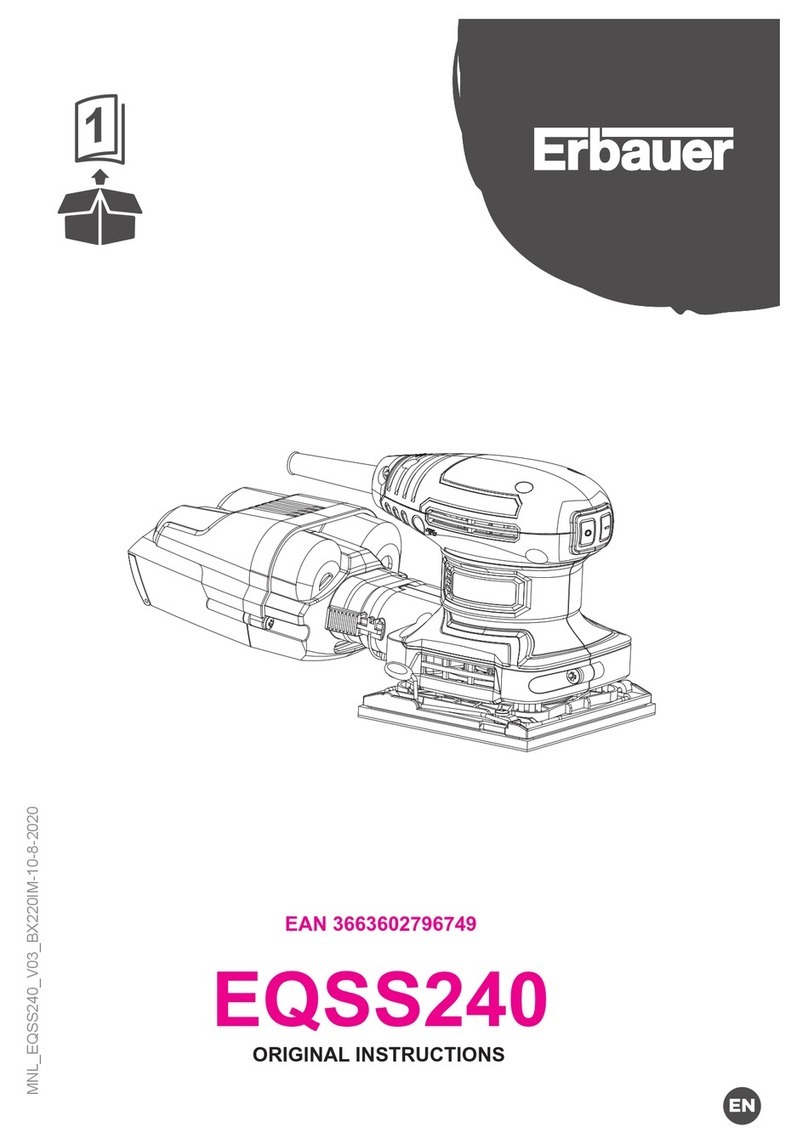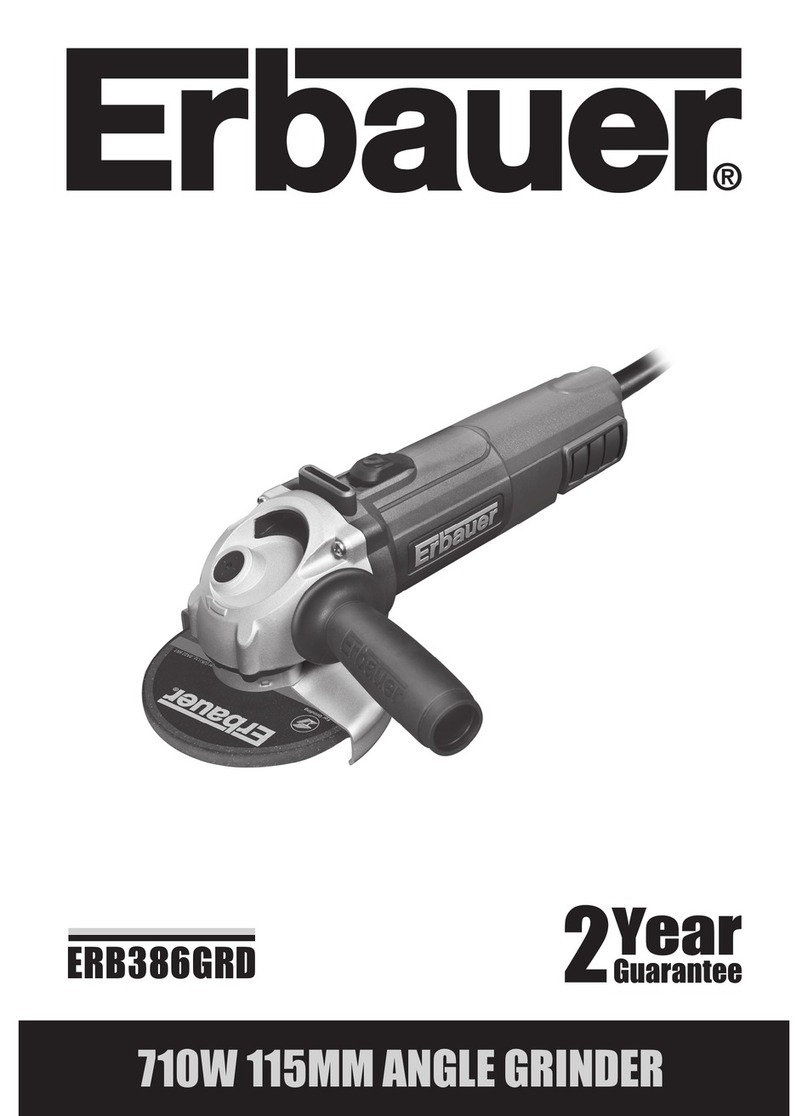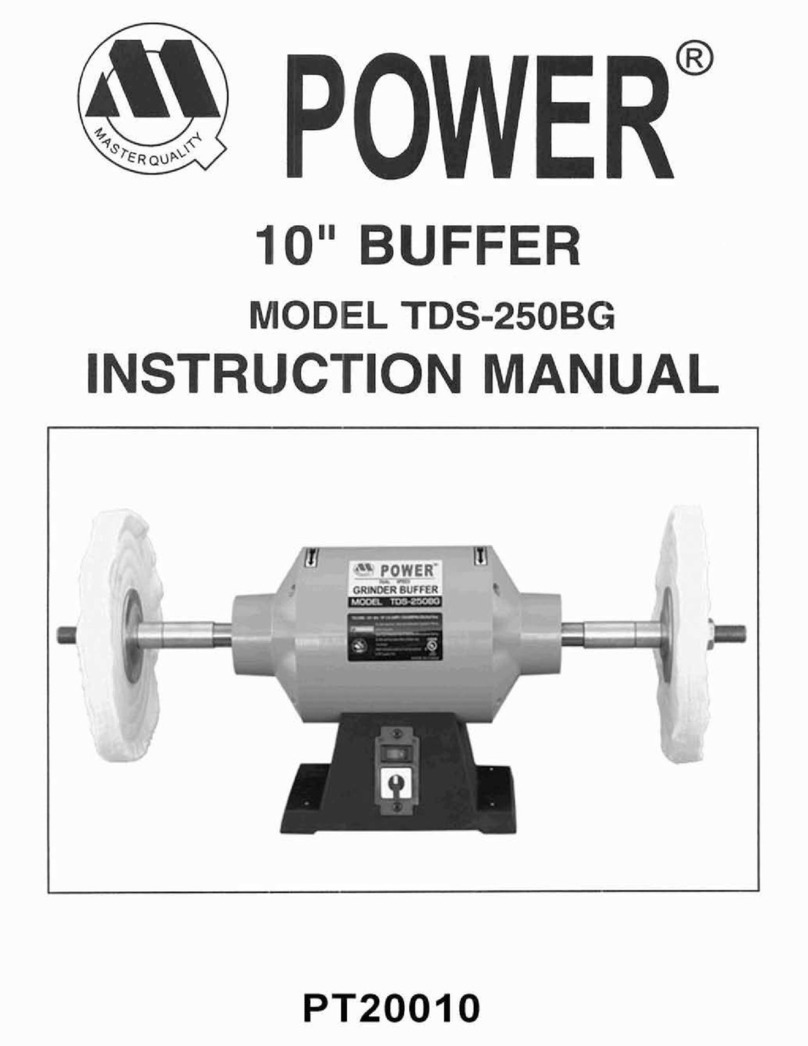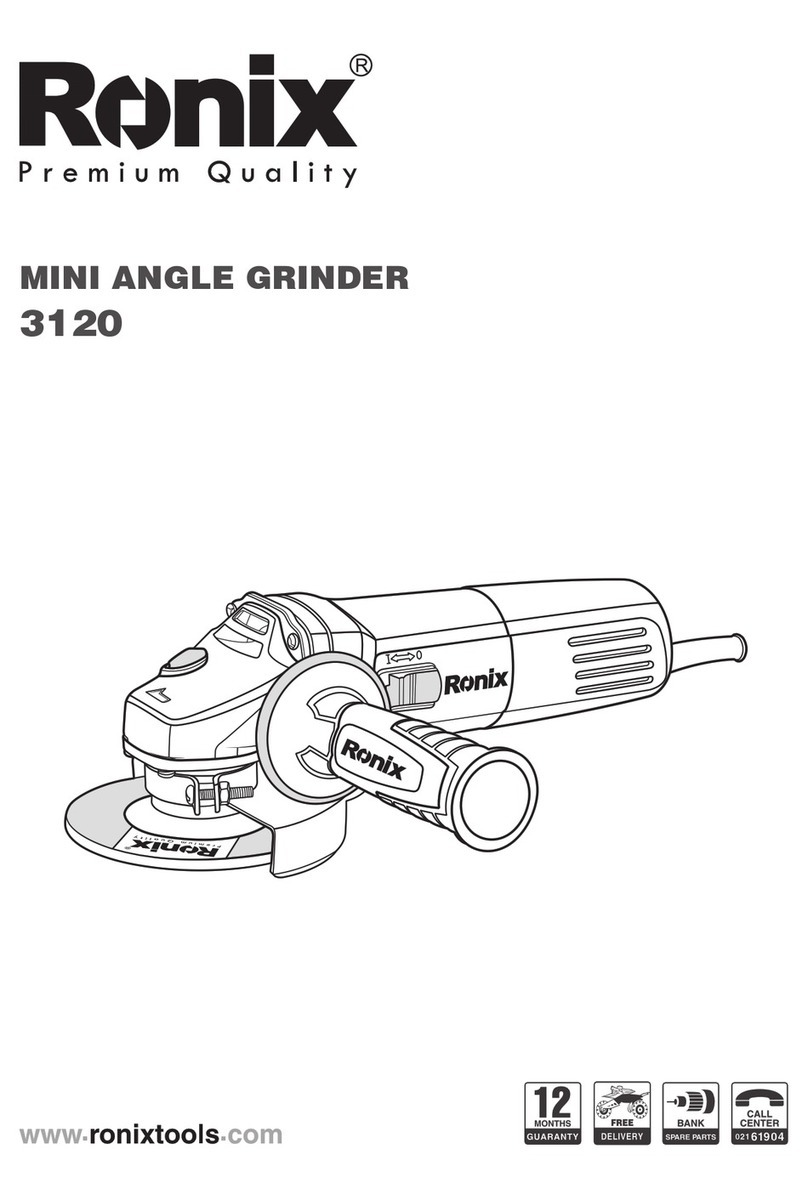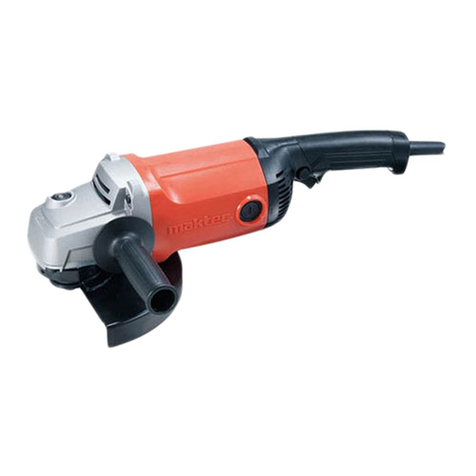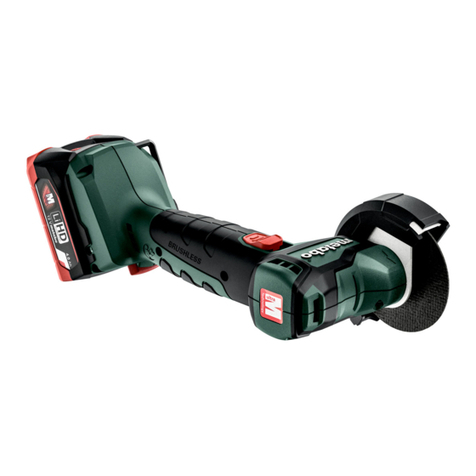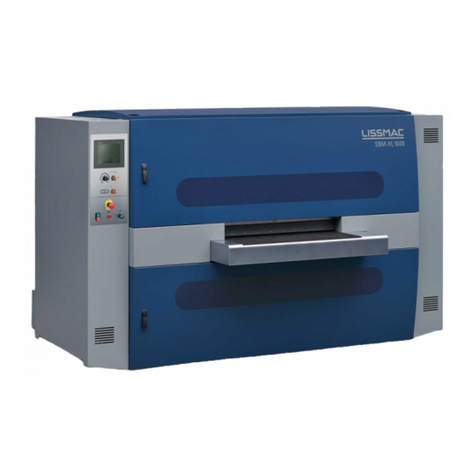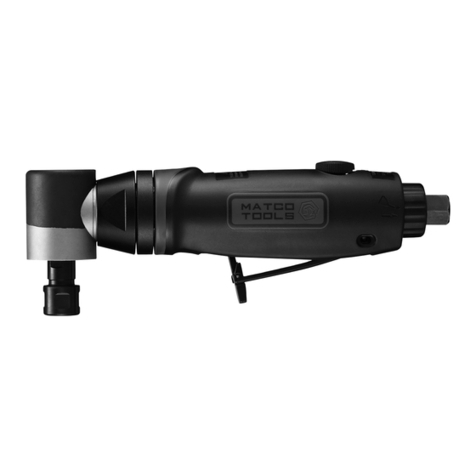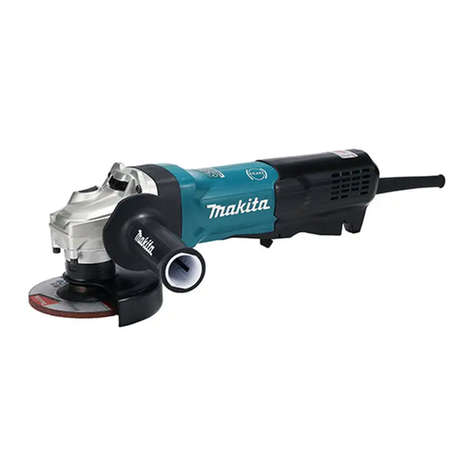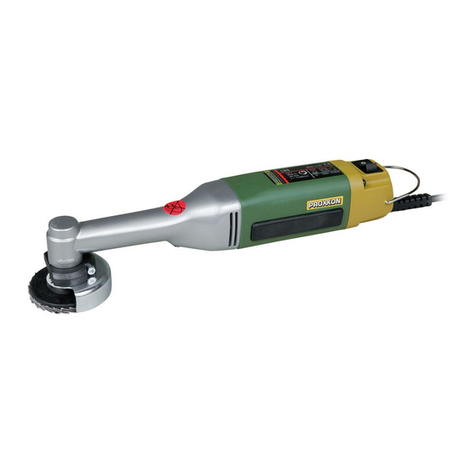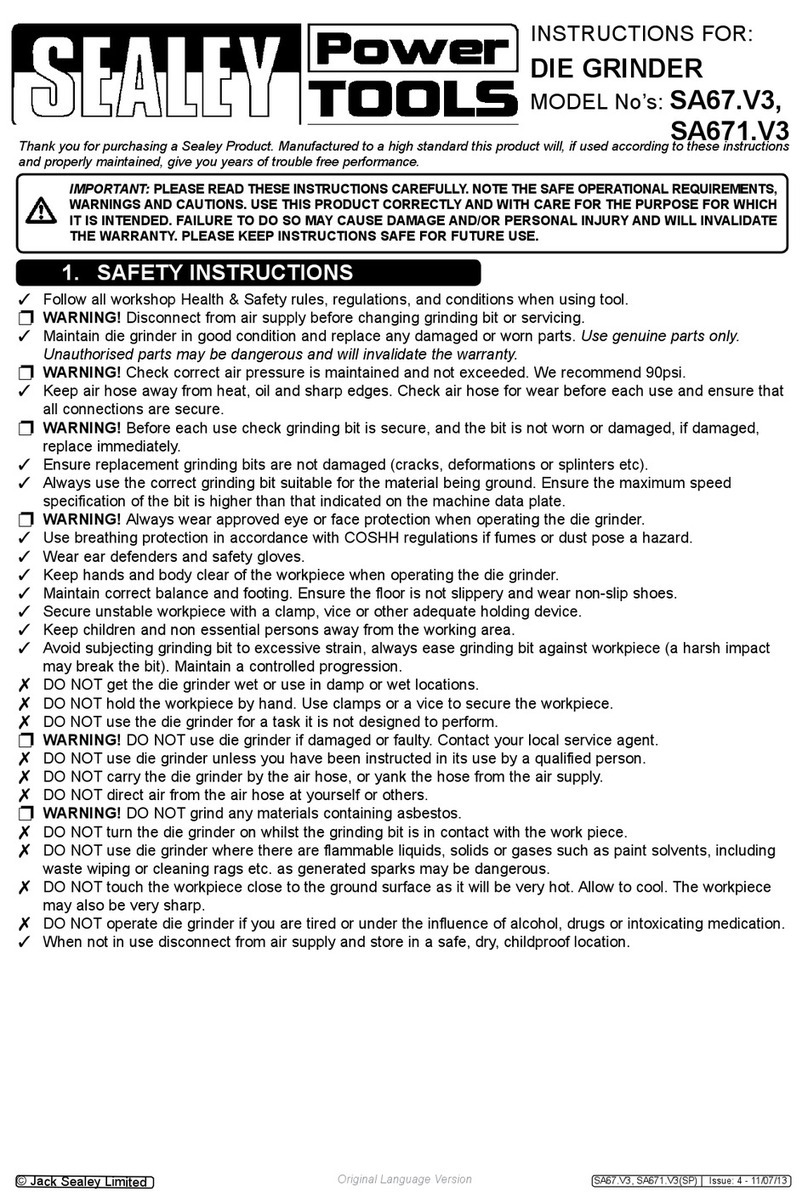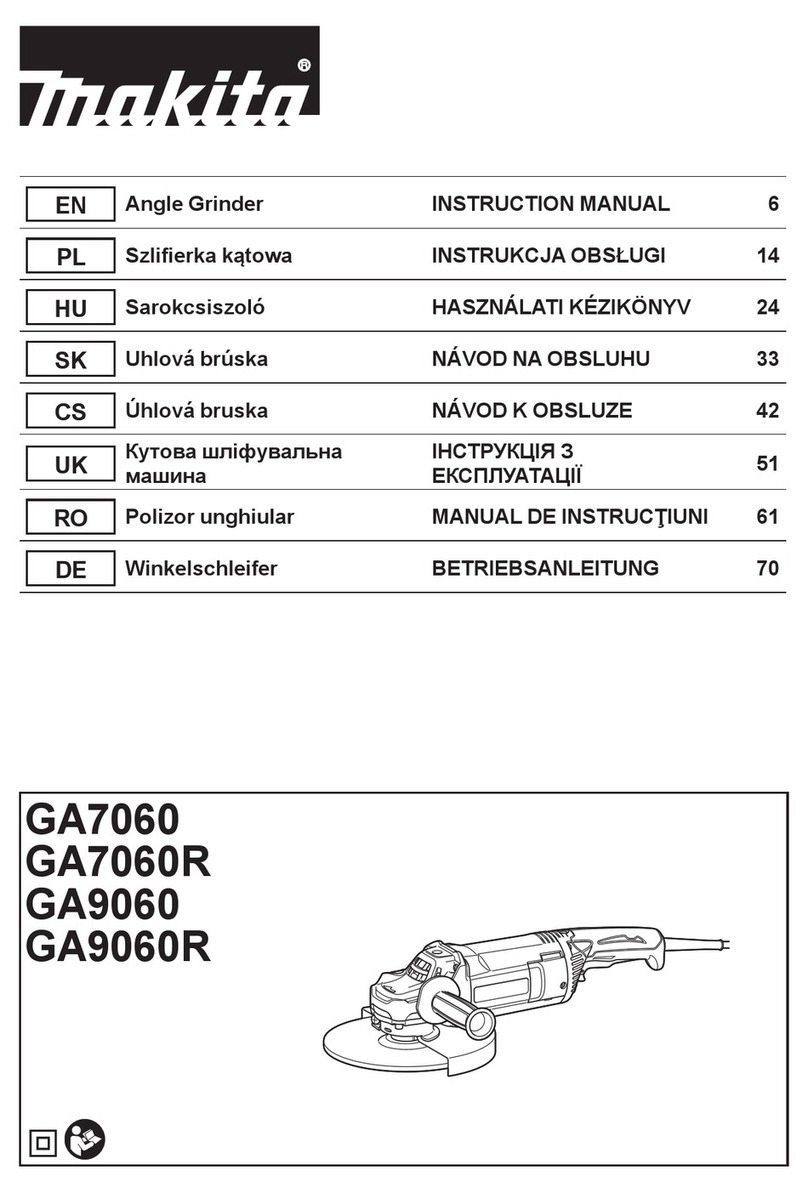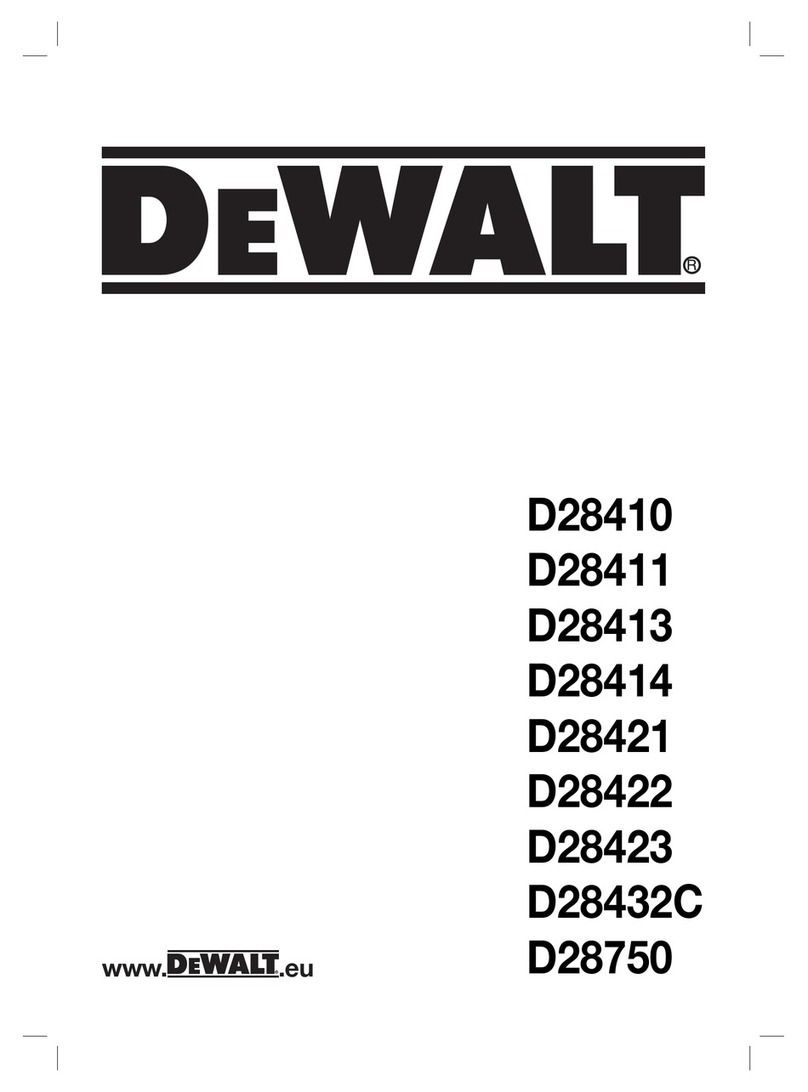Erbauer EAG2200 User manual

MNL_EAG2200_V03_BX220IM_200825
EAG2200
EAN. 3663602795650
ORIGINAL INSTRUCTIONS

2
Safety instructions
Product description
Assembly
Use
Care & maintenance
Guarantee
Declaration of Conformity

3
WARNING! Please read all safety warnings carefully and be sure
that they are fully understood before handling the tool.
x1

4
PRODUCT DESCRIPTION
12
5
6
7
14
13
15
16
17
11
3
2
1
10 9 8
4
A
8
B1
12
11

5
B2 11
16
12
11
16
12
B3
15
C
D E1
E2 F
65
1
2

6
G
15° to 30°
H

7
SAFETY INSTRUCTIONS
GENERAL POWER TOOL SAFETY WARNINGS
WARNING! Read all safety warnings, instructions,
illustrations and specications provided with this
power tool. Failure to follow all instructions listed below
may result in electric shock, re and/or serious injury.
Save all warnings and instructions for future
reference. The term “power tool” in the warnings refers
to your mains-operated (corded) power tool or battery
operated (cordless) power tool.”
WORK AREA SAFETY
a Keep work area clean and well lit. Cluttered or dark areas
invite accidents.
b Do not operate power tools in explosive atmospheres,
such as in the presence of ammable liquids, gases or
dust. Power tools create sparks which may ignite the dust or
fumes.
c Keep children and bystanders away while operating a
power tool. Distractions can cause you to lose control.
ELECTRICAL SAFETY
a Power tool plugs must match the outlet. Never modify the
plug in any way. Do not use any adapter plugs with earthed
(grounded) power tools. Unmodied plugs and matching
outlets will reduce risk of electric shock.
b Avoid body contact with earthed or grounded surfaces,
such as pipes, radiators, ranges and refrigerators. There
is an increased risk of electric shock if your body is earthed or
grounded.

8
c Do not expose power tools to rain or wet conditions. Water
entering a power tool will increase the risk of electric shock.
d Do not abuse the cord. Never use the cord for carrying,
pulling or unplugging the power tool. Keep cord away
from heat, oil, sharp edges or moving parts. Damaged or
entangled cords increase the risk of electric shock.
e When operating a power tool outdoors, use an extension
cord suitable for outdoor use. Use of a cord suitable for
outdoor use reduces the risk of electric shock.
f If operating a power tool in a damp location is unavoidable,
use a residual current device (RCD) protected supply. Use
of an RCD reduces the risk of electric shock.
PERSONAL SAFETY
a Stay alert, watch what you are doing and use common
sense when operating a power tool. Do not use a power
tool while you are tired or under the inuence of drugs,
alcohol or medication. A moment of inattention while
operating power tools may result in serious personal injury.
b Use personal protective equipment. Always wear eye
protection. Protective equipment such as a dust mask, non-
skid safety shoes, hard hat, or hearing protection used for
appropriate conditions will reduce personal injuries.
c Prevent unintentional starting. Ensure the switch is in the
off-position before connecting to power source and/or
battery pack, picking up or carrying the tool. Carrying power
tools with your nger on the switch or energising power tools
that have the switch on invites accidents.
d Remove any adjusting key or wrench before turning the
power tool on. A wrench or a key left attached to a rotating
part of the power tool may result in personal injury.
e Do not overreach. Keep proper footing and balance at
all times. This enables better control of the power tool in
unexpected situations.

9
f Dress properly. Do not wear loose clothing or jewellery.
Keep your hair, clothing away from moving parts. Loose
clothes, jewellery or long hair can be caught in moving parts.
g If devices are provided for the connection of dust extraction
and collection facilities, ensure these are connected and
properly used. Use of dust collection can reduce dust-related
hazards.
h Do not let familiarity gained from frequent use of tools
allow you to become complacent and ignore tool safety
principles. A careless action can cause severe injury within a
fraction of second.
POWER TOOL USE AND CARE
a Do not force the power tool. Use the correct power tool for
your application. The correct power tool will do the job better
and safer at the rate for which it was designed.
b Do not use the power tool if the switch does not turn it
on and off. Any power tool that cannot be controlled with the
switch is dangerous and must be repaired.
c Disconnect the plug from the power source and/or remove
the battery pack, if detachable, from the power tool before
making any adjustments, changing accessories, or storing
power tools. Such preventive safety measures reduce the risk
of starting the power tool accidentally.
d Store idle power tools out of the reach of children and do
not allow persons unfamiliar with the power tool or these
instructions to operate the power tool. Power tools are
dangerous in the hands of untrained users.
e Maintain power tools and accessories. Check for
misalignment or binding of moving parts, breakage of
parts and any other condition that may affect the power
tools operation. If damaged, have the power tool repaired
before use. Many accidents are caused by poorly maintained
power tools.

10
f Keep cutting tools sharp and clean. Properly maintained
cutting tools with sharp cutting edges are less likely to bind and
are easier to control.
g Use the power tool, accessories and tool bits etc. in
accordance with these instructions, taking into account
the working conditions and the work to be performed. Use
of the power tool for operations different from those intended
could result in a hazardous situation.
h. Keep handles and grasping surfaces dry, clean and free
from oil and grease. Slippery handles and grasping surfaces
do not allow for safe handling and control of the tool in
unexpected situations.
SERVICE
a Have your power tool serviced by a qualied repair person
using only identical replacement parts. This will ensure that
the safety of the power tool is maintained.
ADDITIONAL SAFETY INSTRUCTIONS FOR YOUR ANGLE
GRINDER
SAFETY WARNINGS COMMON FOR GRINDING OR ABRASIVE
CUTTING-OFF OPERATIONS:
a This power tool is intended to function as a grinder
or cutoff tool. Read all safety warnings, instructions,
illustrations and specications provided with this power
tool. Failure to follow all instructions listed below may result in
electric shock, re and/or serious injury.
b Operations such as sanding, wire brushing, polishing are
not recommended to be performed with this power tool.
Operations for which the power tool was not designed may
create a hazard and cause personal injury.
c Do not use accessories which are not specically designed
and recommended by the tool manufacturer. Just because
the accessory can be attached to your power tool, it does not
assure safe operation.

11
d The rated speed of the accessory must be at least equal to
the maximum speed marked on the power tool. Accessories
running faster than their rated speed can break and y apart.
e The outside diameter and the thickness of your accessory
must be within the capacity rating of your power tool.
Incorrectly sized accessories cannot be adequately guarded or
controlled.
f Threaded mounting of accessories must match the grinder
spindle thread. For accessories mounted by anges, the
arbour hole of the accessory must t the locating diameter
of the ange. Accessories that do not match the mounting
hardware of the power tool will run out of balance, vibrate
excessively and may cause loss of control.
g Do not use a damaged accessory. Before each use inspect
the accessory such as abrasive wheels for chips and
cracks, backing pad for cracks, tear or excess wear. If
power tool or accessory is dropped, inspect for damage
or install an undamaged accessory. After inspecting and
installing an accessory, position yourself and bystanders
away fromthe plane of the rotating accessory and run the
power tool at maximum no-load speed for one minute.
Damaged accessories will normally break apart during this test
time.
h Wear personal protective equipment. Depending on
application, use face shield, safety goggles or safety
glasses. As appropriate, wear dust mask, hearing
protectors, gloves and workshop apron capable of
stopping small abrasive or workpiece fragments. The eye
protection must be capable of stopping ying debris generated
by various operations. The dust mask or respirator must be
capable of ltrating particles generated by your operation.
Prolonged exposure to high intensity noise may cause hearing
loss.

12
i Keep bystanders a safe distance away from work area.
Anyone entering the work area must wear personal
protective equipment. Fragments of workpiece or of a broken
accessory may y away and cause injury beyond immediate
area of operation.
j Hold power tool by insulated gripping surfaces only, when
performing an operation where the cutting accessory may
contact hidden wiring or its own cord. Cutting accessory
contacting a “live” wire may make exposed metal parts of the
power tool “live” and could give the operator an electric shock.
k Position the cord clear of the spinning accessory. If you
lose control, the cord may be cut or snagged and your hand or
arm may be pulled into the spinning accessory.
l Never lay the power tool down until the accessory has
come to a complete stop. The spinning accessory may grab
the surface and pull the power tool out of your control.
m Do not run the power tool while carrying it at your side.
Accidental contact with the spinning accessory could snag your
clothing, pulling the accessory into your body.
n Regularly clean the power tool’s air vents. The motor’s
fan will draw the dust inside the housing and excessive
accumulation of powdered metal may cause electrical hazards.
o Do not operate the power tool near ammable materials.
Sparks could ignite these materials.
p Do not use accessories that require liquid coolants. Using
water or other liquid coolants may result in electrocution or
shock.
q Your hand must hold on the handle when you are working.
Always use the auxiliary handles supplied with the tool. Loss of
control can cause personal injury

13
KICKBACK AND RELATED WARNINGS
Kickback is a sudden reaction to a pinched or snagged rotating
wheel, backing pad, brush or any other accessory. Pinching or
snagging causes rapid stalling of the rotating accessory which
in turn causes the uncontrolled power tool to be forced in the
direction opposite of the accessory’s rotation at the point of the
binding. For example, if an abrasive wheel is snagged or pinched
by the workpiece, the edge of the wheel that is entering into the
pinch point can dig into the surface of the material causing the
wheel to climb out or kick out. The wheel may either jump toward
or away from the operator, depending on direction of the wheel’s
movement at the point of pinching. Abrasive wheels may also
break under these conditions. Kickback is the result of power tool
misuse and/or incorrect operating procedures or conditions and
can be avoided by taking proper precautions as given below.
a Maintain a rm grip on the power tool and position your
body and arm to allow you to resist kickback forces.
Always use auxiliary handle, if provided, for maximum
control over kickback or torque reaction during start-up.
The operator can control torque reactions or kickback forces, if
proper precautions are taken.
b Never place your hand near the rotating accessory.
Accessory may kickback over your hand.
c Do not position your body in the area where power tool
will move if kick- back occurs. Kickback will propel the tool
in direction opposite to the wheel’s movement at the point of
snagging.
d Use special care when working corners, sharp edges etc.
Avoid bouncing and snagging the accessory. Corners,
sharp edges or bouncing have a tendency to snag the rotating
accessory and cause loss of control or kickback.
e Do not attach a saw chain woodcarving blade or toothed
saw blade. Such blades create frequent kickback and loss of
control.

14
SAFETY WARNINGS SPECIFIC FOR GRINDING AND
ABRASIVE CUTTING-OFF OPERATIONS:
a Use only wheel types that are recommended for your
power tool and the specic guard designed for the selected
wheel. Wheels for which the power tool was not designed
cannot be adequately guarded and are unsafe.
b The grinding surface of centre depressed wheels must be
mounted below the plane of the guard lip. An improperly
mounted wheel that projects through the plane of the guard lip
cannot be adequately protected.
c The guard must be securely attached to the power tool
and positioned for maximum safety, so the least amount
of wheel is exposed towards the operator. The guard helps
to protect operator from broken wheel fragments, accidental
contact with wheel and sparks that could ignite clothing.
d Wheels must be used only for recommended applications.
For example: do not grind with the side of cut-off wheel.
Abrasive cut-off wheels are intended for peripheral grinding,
side forces applied to these wheels may cause them to shatter.
e Always use undamaged wheel anges that are of correct
size and shape for your selected wheel. Proper wheel
anges support the wheel thus reducing the possibility of wheel
breakage. Flanges for cut-off wheels may be different from
grinding wheel anges.
f Do not use worn down wheels from larger power tools.
Wheel intended for larger power tool is not suitable for the
higher speed of a smaller tool and may burst.
ADDITIONAL SAFETY WARNINGS SPECIFIC FOR ABRASIVE
CUTTING-OFF OPERATIONS:
a Do not “jam” the cut-off wheel or apply excessive
pressure. Do not attempt to make an excessive depth
of cut. Overstressing the wheel increases the loading and
susceptibility to twisting or bind- ing of the wheel in the cut and
the possibility of kickback or wheel breakage.

15
b Do not position your body in line with and behind the
rotating wheel. When the wheel, at the point of operation, is
moving away from your body, the possible kickback may propel
the spinning wheel and the power tool directly at you.
c When wheel is binding or when interrupting a cut for any
reason, switch off the power tool and hold the power
tool motionless until the wheel comes to a complete
stop. Never attempt to remove the cut-off wheel from the cut
while the wheel is in motion otherwise kickback may occur.
Investigate and take corrective action to eliminate the cause of
wheel binding.
d Do not restart the cutting operation in the workpiece. Let
the wheel reach full speed and carefully re-enter the cut.
The wheel may bind, walk up or kickback if the power tool is
restarted in the workpiece.
e Support panels or any oversized workpiece to minimize
the risk of wheel pinching and kickback. Large workpieces
tend to sag under their own weight. Supports must be placed
under the workpiece near the line of cut and near the edge of
the workpiece on both sides of the wheel.
f Use extra caution when making a “pocket cut” into existing
walls or other blind areas. The protruding wheel may cut
gas or water pipes, electrical wiring or objects that can cause
kickback.
The following information applies to professional users only but is
good practice for all users:
ADDITIONAL SAFETY WARNING FOR CONSTRUCTION DUST
The updated Control of Substances Hazardous to Health
Regulations 1st October 2012 now also targets to reduce the risks
associated with silica, wood and gypsum dusts.
Construction workers are one of the at-risk groups within this
because of the dust that they breathe: silica dust is not just a
nuisance; it is a real risk to your lungs!

16
Silica is a natural mineral present in large amounts in things like
sand, sandstone and granite. It is also commonly found in many
construction materials such as concrete and mortar. The silica is
broken into very ne dust (also known as Respirable Crystalline
Silica or RCS) during many common tasks such as cutting, drilling
and grinding Breathing in very ne particles of crystalline silica
can lead to the development of: Lung cancer Silicosis Chronic
Obstructive Pulmonary Disorder Chronic obstructive pulmonary
disease (COPD) And breathing in ne particles of wood dust can
lead to the development of Asthma The risk of lung disease is
linked to people who regularly breathe construction dust over a
period of time, not on the odd occasion.
To protect the lung, the COSHH Regulations sets a limit on the
amount of these dusts that you can breathe (called a Workplace
Exposure Limit or WEL) when averaged over a normal working
day. These limits are not a large amount of dust: when compared
to a penny it is tiny – like a small pinch of salt:
This limit is the legal maximum; the most you can breathe after the
right controls have been used.
HOW TO REDUCE THE AMOUNT OF DUST?
1. Reduce the amount of cutting by using the best sizes of
building products.
2. Use a less powerful tool e.g. a block cutter instead of angle
grinder.
3. Using a different method of work altogether – e.g. using a nail
gun to direct fasten cable trays instead of drilling holes rst.
Please always work with approved safety equipment, such as
those dust masks that specially designed to lter out microscopic
particles and use the dust extraction facility at all time.
For more information please see the HSE website: http://www.hse.
gov.uk/construction or http://www.hse.gov.uk/pubns/cis69.pdf

17
WARNING! Some dust particles created by power
sanding, sawing, grinding, drill and other construction
jobs contain chemicals known to cause cancer, birth
defects or other reproductive harm. Some examples of
these chemicals are:
- Lead from lead-based paints.
- Crystalline silica from bricks and cement and other
masonry products.
- Arsenic and chromium from chemically treated timber.
- Your risk from these exposures varies, depending
upon how often you do this type of work. To reduce
your exposure to these chemicals:
- Work in a well-ventilated area.
- Work with approved safety equipment, such as
those dust masks that are specially designed to lter
microscopic particles.
VIBRATION
The European Physical Agents (Vibration) Directive has been
brought in to help reduce hand arm vibration syndrome injuries to
power tool users. The directive requires power tool manufacturers
and suppliers to provide indicative vibration test results to enable
users to make informed decisions as to the period of time a power
tool can be used safely on a daily basis and the choice of tool.
SEE TECHNICAL SPECIFICATIONS IN THE INSTRUCTION
MANUAL FOR THE VIBRATION LEVELS OF YOUR TOOL.
The declared vibration emission value should be used as a
minimum level and should be used with the current guidance on
vibration.
Calculating the actual period of use can be difcult and the HSE
website has further information.

18
The declared vibration emission been measured in accordance
with EN 60745-1& EN 60745-2-3 and may be used to compare
one tool with another tool.
The declared vibration emission value may also be used in
preliminary assessment of exposure.
WARNING! The vibration emission value during actual
use of the power tool can differ from the declared
value depending on the ways in which the tool is
used dependant on the following examples and other
variations on how the tool is used:
• How the tool is used and the materials being cut or
drilled.
• The tool being in good condition and well maintained.
• Use the correct accessories for the tool and ensure
they are sharp and in good condition.
• The tightness of the grip on the handles.
• The tool is being used as intended by its design and
these instructions.
WARNING! Identify safety measures to protect the
operator that are based on an estimation of exposure in
the actual conditions of use (taking account of all parts
of the operating cycle such as the times when the tool is
switched off and when it is running idle in addition to the
trigger time).
While working with this power tool, hand/arm vibrations occur.
Adopt the correct working practices in order to reduce the
exposure to vibration. This tool may cause hand-arm vibration
syndrome if its use is not adequately managed.
Helping to minimise your vibration exposure risk. ALWAYS use
sharp chisels, drills and blades.

19
Maintain this tool in accordance with these instructions and keep
well lubricated (where appropriate).
Avoid using tools in temperatures of 10ºC or less. Plan your work
schedule to spread any high vibration tool use across a number of
days.
NOTE: The use of other tools will reduce the users’ total
working period on this tool.
HEALTH SURVEILLANCE
All employees should be part of an employer’s health surveillance
scheme to help identity any vibration related diseases at an early
stage, prevent disease progression and help employees stay in
work.

20
PRODUCT DESCRIPTION
1. Spindle lock button
2. Mounting threads (×3)
3. Rotary handle lock button
4. Main handle
5. ON /OFF switch
6. Unlock button
7. Air vents
8. Anti-vibration auxiliary handle
9. Cutting safety guard
10. Guard clamping lever
11. Inner ange
12. Outer ange
13. Spindle
14. Grinding safety guard
15. Spanner
16. Grinding/Cutting wheel (not included)
17. Clamp adjustment bolt
01 TECHNICAL SPECIFICATIONS
Rated voltage, frequency: 220 – 240 V~ ,50 Hz
Rated power input: 2200 W
Rated no load speed n: 6600/min
Protection class: II /
Spindle thread M14
Maximum wheel diameter Φ230mm
Maximum thickness of grinding wheel 6mm
Wheel bore Φ22.23mm
Machine weight 6.5kg
Table of contents
Other Erbauer Grinder manuals
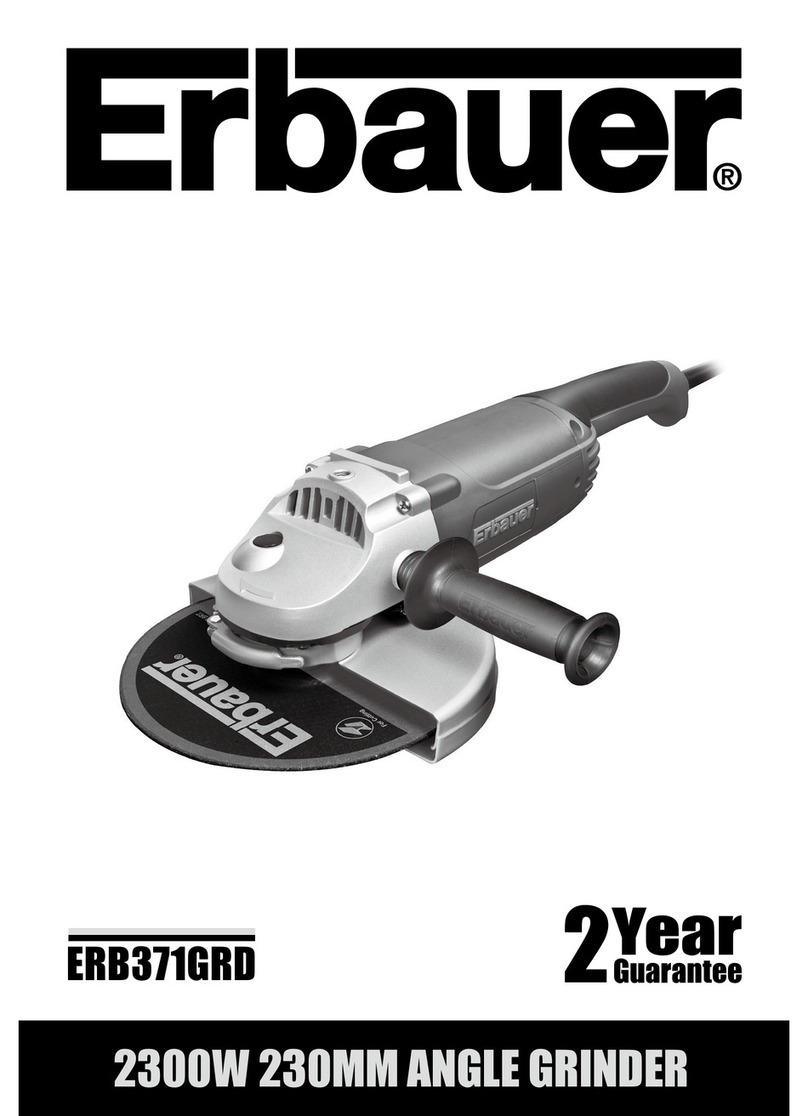
Erbauer
Erbauer ERB371GRD User manual

Erbauer
Erbauer ERB013GRD User manual

Erbauer
Erbauer ERB612GRD User manual

Erbauer
Erbauer ERB666GRD User manual
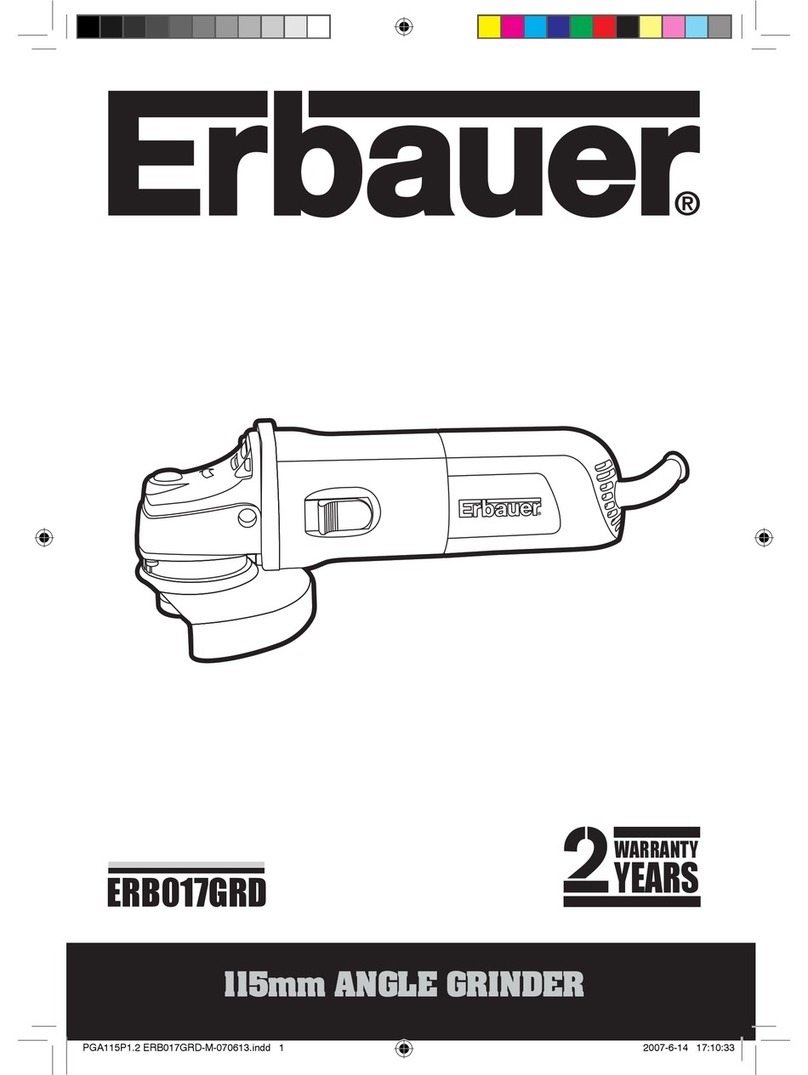
Erbauer
Erbauer ERB017GRD User manual

Erbauer
Erbauer EAG18-Li User manual
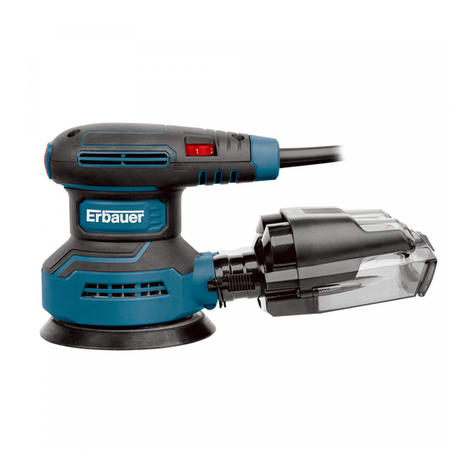
Erbauer
Erbauer ERO400 User manual

Erbauer
Erbauer ERB8DLC User manual
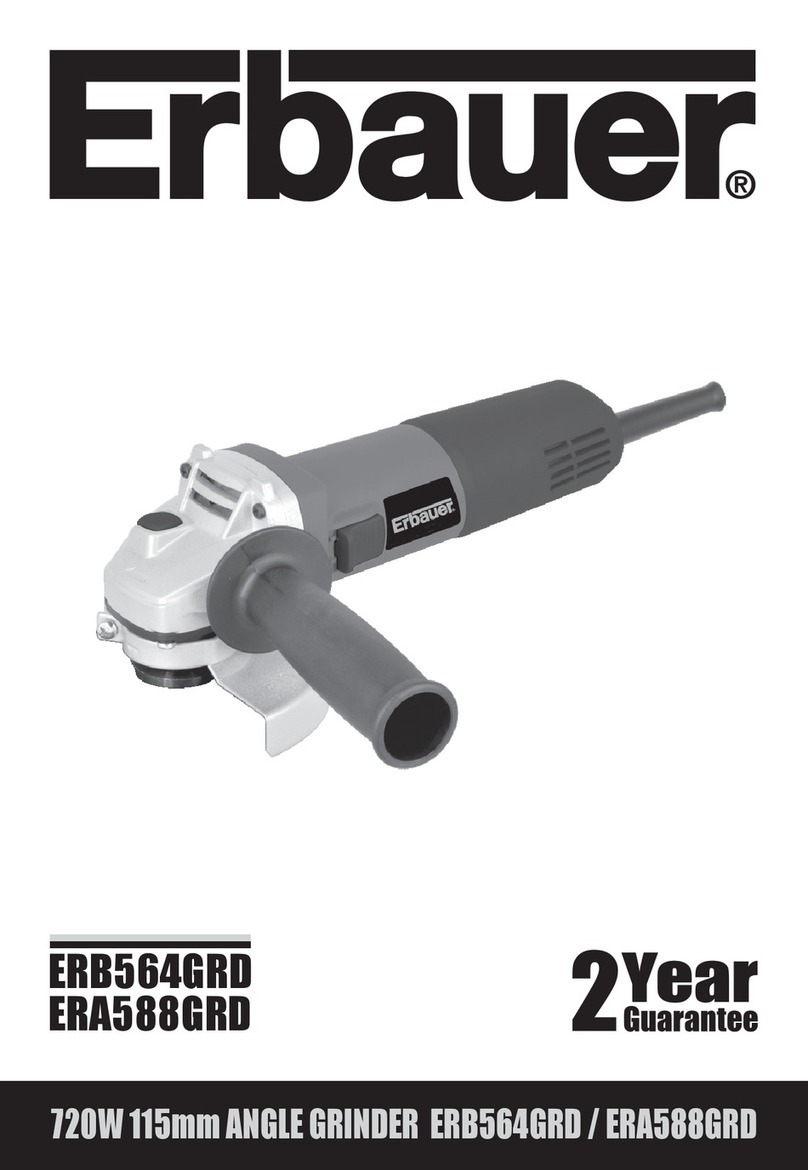
Erbauer
Erbauer ERB564GRD User manual
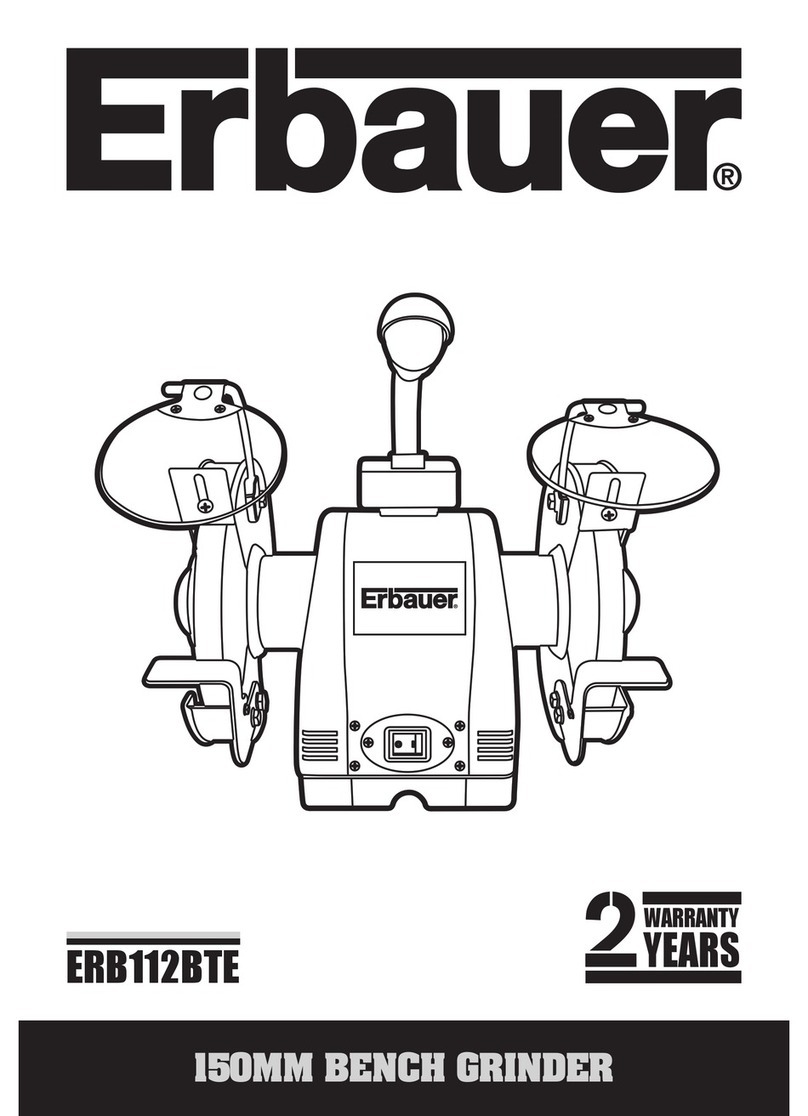
Erbauer
Erbauer ERB112BTE User manual
